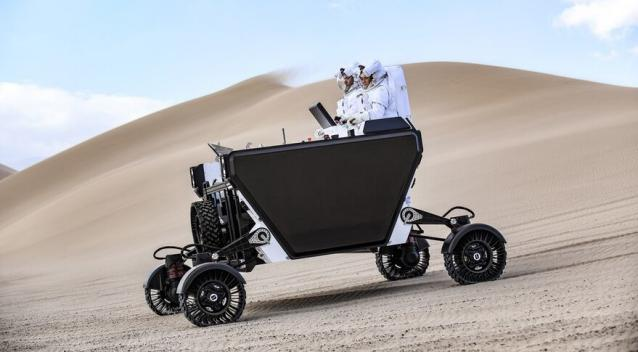
California-based Venturi Astrolab uncovered its working model of the vehicle last week. The explorer, or rover, is called FLEX. Astrolab officials say the four-wheeled rover was designed to be sent to the moon by the American space agency NASA. FLEX was developed to transport astronauts and cargo and support a series of lunar activities and experiments.
If NASA chooses to use the vehicle, it will become part of the Artemis program, which aims to return humans to the moon as early as 2025. It also calls for establishing a long-term base on the moon that could one day launch astronauts to Mars. FLEX could become the first astronaut-transporting vehicle to visit the moon since NASA’s Apollo 17 mission in 1972. Apollo 17 was the last of six American manned missions to the moon.
Retired Canadian astronaut Chris Hadfield recently test drove the vehicle. He said in a video released by Astrolab that rovers used during the Apollo missions were built purely for exploration purposes. But, Hadfield added, FLEX was designed to support astronauts landing on the moon for long-term stays. “Once you get there, you’ve got to be able to move things around,” he said. “You also need to transition the equipment that keeps you alive and that enables the activities.” Hadfield added: “When we settle somewhere, we don’t only need to get people from one place to another, but we need to move hardware(硬件设备), cargo, life support equipment and more.”
Apollo 17’s rover set a moon speed record of 17.7 kilometers per hour. Astrolab chief Jaret Matthews says FLEX can move just as fast. To operate FLEX, astronauts stand in the back and control the vehicle with a joystick(操纵杆) device. The vehicle weighs about 500 kilograms,but can carry loads up to 1,500 kilograms, Astrolab officials say. With its sun-powered batteries fully charged, FLEX is designed to operate continuously for up to eight hours. Matthews said the vehicle’s energy storing system can survive the extreme cold of a lunar night and the rover can operate in total darkness.
本时文内容由奇速英语国际教育研究院原创编写,未经书面授权,禁止复制和任何商业用途,版权所有,侵权必究!(作者投稿及时文阅读定制请联系微信:18980471698)
1.What can we know about FLEX from the passage?
A It is a part of the Artemis program.
B It has been adopted by NASA as a lunar vehicle.
C It is a new space vehicle built to explore the moon.
D It is a standard means of transportation on the moon.
解析:选C。C 细节理解题。根据第一段的“California-based Venturi Astrolab uncovered its working model of the vehicle last week. The explorer, or rover, is called FLEX.”可知,总部位于加利福尼亚州的文丘里太空实验室(Venturi Astrolab)公布了一款月球车的工作原型,它被称为FLEX。故选C。
2.What is the Artemis program mainly about?
A Launching the astronauts to Mars.
B Completing NASA’s Apollo 17 mission.
C Setting up a base temporarily on the moon.
D Launching astronauts to the moon again.
解析:选D。D 细节理解题。根据第二段一二句“If NASA chooses to use the vehicle, it will become part of the Artemis program, which aims to return humans to the moon as early as 2025. ”可知,该项目的目标是最早在2025年让人类重返月球。故选D。
3.What makes FLEX different from rovers of Apollo missions?
A Its design purpose.
B Its cost of development.
C Its working principles.
D Its designed service life.
解析:选A。A 推理判断题。根据第三段的“He said in a video released by Astrolab that rovers used during the Apollo missions were built purely for exploration purposes. But, Hadfield added, FLEX was designed to support astronauts landing on the moon for long-term stays.”可知,阿波罗任务中使用的月球车纯粹是为了探索目的而建造的。但FLEX的设计是为了支持宇航员在月球上长期停留。由此说明它们两者的设计意图是不同的,故选A。
4.What is the last paragraph mainly about?
A Contrast between different rovers.
B Features and functions of FLEX.
C Moving speed of Apollo 17’s rover.
D How to operate FLEX on the moon.
解析:选B。B 段落大意题。文章最后一段介绍了FLEX在月球上的移动速度、操作方式,载货重量、蓄电量、耐寒以及在黑暗中运行等,这些都是关于FLEX的特征和功能的介绍。故选B。